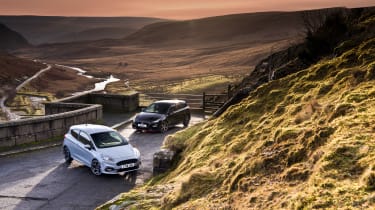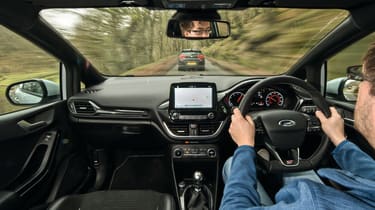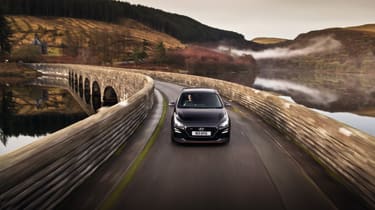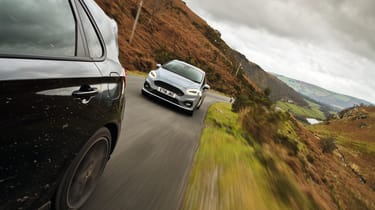Hyundai i30 N vs Ford Fiesta ST - rally-derived hot hatches go head-to-head
The closest showroom cars you can get to present-day WRC contenders are Hyundai’s i30 N and Ford’s Fiesta ST. Which of these hot hatches better transfers that competitive spirit to the road?

A moonless Sunday evening, heading for Rhayader, mid-Wales, on roads that the satnav system has chosen. They’re new to me but, as ever, I’m taking the predicted ETA as a target time to beat. (Don’t we all?) It’s a challenge the Fiesta ST is up for; it’s so willing, so grippy. The character of the route changes frequently and at times the little Ford flows beautifully, dissecting the road with an economy of effort that makes me grin.
The Fiesta was the working-class hero of our recent evo Car of the Year contest (issue 257), a car that seemed as honed and focused as the supercars it was up against, but at a fraction of the price. I got to take it home afterwards and have since put another 5000 miles on it, so I reckon I know it inside out. Its star quality still shines brightly. But how will it fare against another hot hatch that’s highly regarded in this parish, the Hyundai i30 N?
They’re from adjacent segments but when similarly specced they’re surprisingly close on price. The 247bhp i30 N is £25,995 and comes fully kitted, the only option being paint colour. In ST-3 trim with five doors the Fiesta is just over £2k less when you add the highly desirable £925 ST Performance Pack (Quaife limited-slip differential, shift lights and launch control) to the £22,895 list price.
> Hyundai i30 N review - a great first try at hot hatch heroics
I must admit that when we rendezvous next morning on Rhayader high street I’m not wowed by the Hyundai’s looks. I like the 271bhp Performance version and although this one still has the rear spoiler and red striped front splitter and rear diffuser, on 18-inch alloys rather than the 19s it suddenly looks a bit ordinary, a bit weedy. The Fiesta looks sharper, with a more aggressive stance, and appears to be riding on much bigger wheels. In fact they’re also 18s, and shod with slightly slimmer tyres (205/40 versus 225/40).
The Fiesta drives like it looks, with an immediacy that takes a little getting used to. The steering is very positive, with a fast ratio that gives the car an eagerness that the front end (helped by the Quaife diff and Michelin Pilot Super Sport tyres) has no trouble translating into scalpel-sharp turn-in, seemingly in any conditions. The burbly 1.5-litre three-pot engine is keen too, while the shift is slick and positive, and the ride firm, all of which makes the ST feel on high alert right from the off.
First impressions of the Hyundai are that it’s more measured. It doesn’t have Recaro-branded seats but they’re well shaped and offer a welcoming embrace. The gearshift is less positive, the steering feels slow off-centre, its efforts a little high on lock, and there’s a lot of road noise compared to the Fiesta. And while the interior is well equipped, its facia design is quite forgettable. So far, so ordinary, then.
Its 2-litre four-cylinder engine is smooth but doesn’t sound as characterful or loud… then you give the throttle a decent squeeze and the Hyundai springs its first surprise, lunging forward with Fiesta-beating urge. It may be a bigger car and at 1400kg some 213 kilos heavier than the Ford, but the Hyundai’s power and torque advantage – 247bhp versus 197 and 260lb ft versus 214 – leave the Fiesta feeling a bit breathless in the lower gears. Claimed figures suggest the i30 N just has the edge to 62mph, making the dash in 6.4sec, a tenth of a second quicker.
When you’re not working it though, the Hyundai feels a bit laid-back. However, there are more tuning opportunities; adjustable dampers are the i30 N’s main technical advantage over the Fiesta, but staffer Antony Ingram, who drove here in the i30 N and ran a Performance version as a long-termer last year, reckons the default Normal setting is all you need for the road. The other options are unhelpfully stiff, he says. ‘Even the Hyundai engineers say they’re best reserved for smooth tracks.’
A tinker with the menu options on the large central screen reveals that, for me, the steering isn’t improved by deviating from Normal either, Comfort being too light and Sport far too heavy. What can be improved is the response of that already zingy engine. In its Sport+ mode it feels considerably more responsive on part-throttle, so much so that the whole car seems sharper, more enthusiastic.
The reason we have met in Rhayader is that the wonderful Elan Valley is on its doorstep. It’s prime hot hatch territory. Anything bigger than a 3-series quickly starts to feel unwieldy, and no stretch of road exemplifies this more than the one on the north side that drops down to the valley floor and heads off towards Aberystwyth. It’s a humdinger, a narrow, lumpy, rollercoaster of a road that can wrong-foot cars (and drivers).
The motor of the Hyundai isn’t as vocal as the peppier version in the Performance model, but there’s a bit of twin-cam-style twang coming through the bulkhead and there’s lots of low-down response and a rewarding build to the red line. The revelation that quickly dawns is that down this demanding squiggle of asphalt the i30 N is right at home.
I was expecting it to get a bit looser, a bit more approximate, given how ordinary it feels at an amble. The opposite is true: the more you ask of it, the better it gets. And it’s not just expectation versus reality; the composure of the i30 N is quite astonishing. The pressure it soaks up, the grip it finds and the precision of its steering and damping are exceptional. The crests and dips, the bridge hops, the blind and late-tightening corners, the ragged-surfaced apexes… all are dealt with, defused, with such ease. And at a pace that I can imagine few cars matching.
It’s one of the most unexpected and brilliant demonstrations of dynamics I’ve had the pleasure of enjoying in a while. If you’ve watched the current crop of WRC cars – including Hyundai’s i20 – threading their way down a rough, twisting, cambered road at speed and marvelled at how they look sucked to the road, that’s how the i30 N feels – hooked up and on the exact line demanded.
‘It’s good, isn’t it?,’ says Antony when he arrives at our car park muster point in the Fiesta, which he appears unimpressed by. He reckons the ‘HN’-marked 18-inch Pilot Super Sports give a marginal gain in ride comfort compared to the 19-inch P Zeros on his old long-termer, but – more significantly – that there’s not much less grip. I agree. And save for a bit of scrabble and judder when you gun the throttle hard in the lower gears, the i30 N doesn’t seem to miss the limited-slip diff of the Performance model, either.
The secret of its success, he says, is that the bodyshell is seam-welded, significantly increasing stiffness. He then pops the tailgate open, revealing a substantial brace beam between the rear suspension turrets that adds more stiffness (and ruins its load-through ability!). The upshot is the suspension does what it’s supposed to do, uncorrupted by body flex.
I already know that the Fiesta is going to struggle to match the i30 along here. Most cars would, but I also know that this is the sort of road the ST finds most tricky. Sure enough, within a couple of corners it’s feeling tall and narrow, stiff and a bit bouncy. There’s more steering feedback but it’s more distracting kickback than feel.
There’s plenty of grip but it feels like the little Ford is fighting the surface where the Hyundai neutralises and absorbs its imperfections. And while the ST’s performance is punchy, I know I’m not using as much of it and so I’m travelling less briskly. There’s an abruptness about the Fiesta on this sort of road, and the brake feel doesn’t help; a bit of grab at the top of the pedal makes it tricky to smoothly blend the Fiesta into the turns. In short, it’s an unsatisfying, wild ride.
Here’s the thing though: when we’re back on regular roads and the pace is more ordinary, the Fiesta is more fun. It’s suffused with hot hatch character through its taut chassis, keen steering and warbly three-cylinder motor. It feels like it’s always up for it, and provided the surface isn’t too challenging, it’s easy enough to live with. In comparison, the i30 N goes from being Superman to Clark Kent. Ride control is still good but road noise intrudes once more, the steering and shift feel plain, and overall it feels quite ordinary again.
Antony agrees, up to a point: ‘The Fiesta’s character is more “up for it” than the i30. It leaps forward on relatively little throttle, its steering needs barely any effort or input to dive around a corner, it follows cambers more, scrabbles out of corners more, bounces around on uneven surfaces… Only some of this stuff is actually desirable in a hot hatch…’
The Hyundai, on the other hand, he finds perfectly judged for road driving: ‘Despite being pretty viceless and composed it’s still fun; it gives me more confidence than the Fiesta but rewards more too. It’s also the one I’d prefer to live with. It’s not so big that you’d wish for something more compact on really tight roads, but the extra space, comfier seats, better ride and less droney exhaust would make it easily my choice as a daily driver.’ I agree with the practicality – it’s not big, yet four six-footers and their luggage would find enough room – but I’m not totally convinced yet.
The afternoon’s roads play to both cars’ strengths, being smoother and faster. The Fiesta still makes a bit of a fuss of some surfaces, but when you can read the corner and commit early, the sharpness of turn-in and grip are dizzying. There appears to be no understeer at all; you turn the wheel, the car obeys, and the rear tries to keep up, which can get it sliding on greasy roads…
The i30 N needs a bit of commitment to really shine, but shine it most certainly will. Its brakes are smaller than the Performance model’s but are beautifully judged for general use, with superb weight, feel and response. Along with precise, calm steering and great poise, you get into a very satisfying flow on quick, sinuous A- and B-roads. And even when you think you may have come into a fast wet corner a bit too hot, the level of grip the i30 finds exceeds expectation.
The many development hours spent at Hyundai’s Namyang R&D Centre in Korea and at the Nürburgring have clearly paid off. The dynamic character and competence of the i30 N should perhaps come as no surprise given the German engineering talent Kia/Hyundai has employed. There’s even a familiar feel to some of its features: the options for tailoring its character and the extended band of orange rev counter lights from cold, encouraging modest revs until the engine is warm, have the ring of BMW about them.
The Hyundai is a very well sorted car and the more practical and rounded package; more spacious, more everyday useable, but able to raise its game to a level that’s quite astonishing. The harder you push it, the better it gets. If you have a family and can have only one car, it’s a compelling proposition, playing the role of undemanding family car during the week but able to work on a different level for a deeply satisfying one-up hack on a Sunday morning.
On the other hand, the snorty, stiffly sprung Ford is raring to go all the time – it’s a live wire. It operates impressively but over a narrower bandwidth than the Hyundai. It’s up for it from the moment the wheels start turning, from the moment the engine fires up, in fact, with its mellow triple crooning away. Its hunger for corners is inspiring, even in town. It unravels a bit on the sort of road that the Hyundai effortlessly tames, but on smoother roads its corner-scything demeanour is an absolute blast.
There’s even less crossover between this pair than you might expect; if they were represented on a Venn diagram, the area of intersection would be quite small. The Fiesta is in the business of instant gratification compared with the Hyundai, which is a master of delayed fulfilment. Whichever one suits your lifestyle, you won’t be disappointed.
Ford Fiesta ST
| Engine | In-line 3-cyl, 1497cc, turbo |
| Power | 197bhp @ 6000rpm |
| Torque | 214lb ft @ 1600-4000rpm |
| Weight | 1187kg |
| Power-to-weight | 169bhp/ton |
| 0-62mph | 6.5sec |
| Top speed | 144mph |
| Basic price | £22,245 (three-door ST-3) |
Hyundai i30 N
| Engine | In-line 4-cyl, 1998cc, turbo |
| Power | 247bhp @ 6000rpm |
| Torque | 260lb ft @ 1500-4000rpm |
| Weight | 1400kg |
| Power-to-weight | 179bhp/ton |
| 0-62mph | 6.4sec |
| Top speed | 155mph (limited) |
| Basic price | £25,995 |







